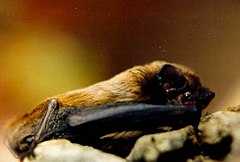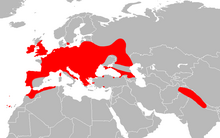Lesser Noctule
| Lesser noctule/Leisler's bat | |
|---|---|
 |
|
| Scientific classification | |
| Kingdom: | Animalia |
| Phylum: | Chordata |
| Class: | Mammalia |
| Order: | Chiroptera |
| Family: | Vespertilionidae |
| Genus: | Nyctalus |
| Species: | N. leisleri |
| Binomial name | |
|
Nyctalus leisleri (Kuhl, 1817) |
|
 |
|
The lesser noctule or Leisler's bat (Nyctalus leisleri) is a species of bat belonging to the vesper bat family, Vespertilionidae.
It is a medium-sized bat, slightly smaller than the common noctule. It has a length of 48 to 68 mm (head and body) and a wingspan of 260 to 330 mm. The forearm measures 38 to 47 mm and the bat's weight is 11 to 20 grams. The face, ears and wings are dark. The fur is brown, darker at the base than the tip unlike that of the common noctule which is the same colour all along its length. The undersides of the arms are hairy giving it the alternative name "hairy-armed bat". The ears are short and rounded with a mushroom-shaped tragus. The wings are long and narrow.
The lesser noctule is found locally across Europe and western Asia, eastwards as far as the Urals and Himalayas. It is also found in north-west Africa, the Canary Islands and Madeira. The form in the Azores is often considered to be a separate species - Azores noctule (Nyctalus azoreum).
It is typically found in forests, both coniferous and deciduous, but has also adapted to parkland and urban areas and frequently roosts in buildings.
In most parts of its range, the lesser noctule is rare but in Ireland it is much more common. In Britain it is known from a few colonies in England and Wales with occasional wanderers reaching Scotland. Threats to its survival include declines in large insects, loss of forest and hollow trees and toxic chemicals found in treated timber in buildings.
The bats emerge soon after sunset to feed on flying insects such as moths and beetles. They fly straight and fast with shallow dives, often at treetop level. They sometimes feed around streetlights, catching the insects attracted to them. They are most active around dusk and dawn and will travel up to 10 km while foraging.
...
Wikipedia

